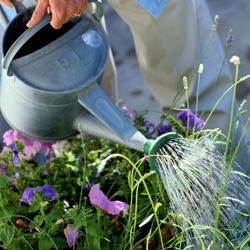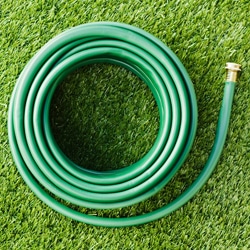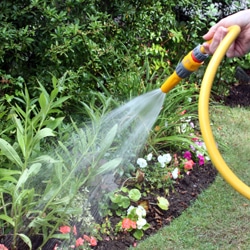Watering: How Much and When?
Water is critical for a healthy garden and landscape, but how much water is too much, how much isn’t enough and how much is just right? Unfortunately, there isn’t a specific answer that suits every gardener’s needs. All plants have different water requirements, which change depending on the type of soil, amount of sun, temperature, humidity, season, maturity of the plant and overall growing environment. It is important to understand how to properly water plants!
Initial Watering
No matter what time of year, ALL plants, including specimens described as drought tolerant, will require water when first planted! This is because many of the smaller roots responsible for water uptake are usually damaged during shipment and planting. Hopefully you have properly amended your soil and slowly mindfully water while it percolates into the soil. Digging a slight semi circle water well around the plant can help keep water where you want it .Watch new plants carefully and keep them well-watered as their roots settle in and they adapt to their new or transplanted location.
Groups Are Good
It’s a good idea to have some knowledge of the plant’s water requirements when determining the location in the garden. It will keep watering simple if you plant a new specimen near other plants with similar water requirements. In this way, there is no need to readjust an irrigation system or watering schedule, since all the plants in the group have similar needs.
Need a Drink?
Because plants’ watering needs can change through the season, how can you tell if a plant needs more water? It is best to do it before you see the telltale signs! Most plants will wilt as the soil becomes too dry. The leaves may droop, and if it’s an upright plant, the top ends may become soft and bend over. Glossy plants may begin to look dull, while thick leaves will shrivel. If you notice these signs, it is past time to water! Most plants will revive if watered quickly enough, but be sure to water deeply rather than allowing moisture to run off the surface.
How can you tell if you should water? Push your finger into the soil an inch or two from the base of a plant. Perfect soil should feel cool and slightly moist. Some soil should stick to your finger. If none does, it’s too dry. If it’s muddy, don’t water. Overwatering kills plants by depriving the roots of oxygen. Some gardeners use water meters to see the precise amount of moisture. If you’re unsure, this tool can be helpful.
Adjusting Your Watering Schedule
The amount you have to water your plants or landscape can change from day to day. A cool morning will allow more dew to form and drain to the soil, or a sudden afternoon thunderstorm can be enough water to keep your plants hydrated for a few days. If it is a gusty storm with lots of wind, it may not adequately water everything equally. An overly hot day, however, can rapidly deplete water resources and extra watering may be required. Check your plants and landscape regularly to be sure they are getting adequate water, and make adjustments as needed to keep them suitably moist without either too much or too little water.
Need help monitoring water? Stop by to see our collection of water gauges, meters and monitors that can help you be sure you are watering your landscape correctly. Getting out there and checking the soil is still the best way to tell!















